|
|
|
Copyright ©1998 by The Resilience Alliance*
Bernow, S., and M. Duckworth. 1998. An evaluation of integrated climate protection policies for the United States. Conservation Ecology [online]2(2): 1. Available from the Internet. URL: http://www.consecol.org/vol2/iss2/art1/A version of this article in which text, figures, tables, and appendices are separate files may be found by following this link.
Perspective An Evaluation of Integrated Climate Protection Policies for the United States Stephen Bernow and Max Duckworth
Tellus Institute
- Abstract
- Introduction
- Description of the Innovation Path
- Analysis and Results
- Conclusion
- Responses
- Acknowledgments
- Literature Cited
This paper presents and discusses an integrated set of policies designed to reduce U.S. carbon emissions over the next four decades. This innovation path also aims to promote environmental quality, particularly by reducing emissions of criteria air pollutants, to reduce U.S. dependence on imported oil, and to induce technological innovation and diffusion in energy production and consumption. The innovation path would reduce economy-wide carbon emissions by 26% below baseline projections for 2010 and by 62% below baseline projections for 2030; this translates into 10% below 1990 levels in 2010 and 45% below 1990 levels in 2030. Emissions of criteria pollutants also would be significantly reduced, as would petroleum imports by the United States. Moreover, the innovation path would yield cumulative net savings for the United States of $218 billion (1993 dollars) through 2010, or $19 billion on a leveled annual basis, and would result in 800,000 additional jobs nationwide by 2010. Although the overall findings from the innovation path analysis are robust, the results should be taken as indicative, rather than precisely predictive, owing to uncertainties in future costs, prices, technology performance, and consumer behavior.
KEY WORDS: air pollutants, carbon emissions, climate change policy, costs and benefits, innovation path analysis, U.S. economy.
The potential for global climate disruption, arising largely from carbon dioxide emissions released into the atmosphere from fossil fuel combustion, threatens severe physical, economic, ecological, health, demographic, and political consequences. This threat has mobilized the international community into negotiations for legally binding limits on carbon emissions. Although the United States, which contributes >20% of the world's carbon emissions annually (World Resources Institute 1996) has agreed in principle to such limits for the post-2000 period, it has yet to propose specific targets.
The very high carbon : GDP ratio of the United States, which stems from its high-intensity use of energy, might suggest that compliance with climate protection goals would be costly to the economy. However, there exist many cost-effective opportunities to reduce greenhouse gas and pollutant emissions from all sectors of the U.S. economy. This paper summarizes an analysis of policies that would bring about substantial reductions in energy use and carbon emissions in the United States over the next four decades. The technology assumptions in the near-to-medium term (the pre-2010 period) are deliberately cautious, limited to commercially available products or straightforward evolutionary improvements of existing products. The policies designed to accelerate diffusion of these more efficient and low-carbon technologies in the near term, and the resulting deployment and use of these technologies, can help to stimulate even greater major technological advances in the longer term.
The full "Energy Innovations (1997)" study is available at http://www.tellus.org/ei. It was conducted by a collaboration of five organizations: Alliance to Save Energy, American Council for an Energy-Efficient Economy, Natural Resources Defense Council, Tellus Institute, and Union of Concerned Scientists.
The individual policy measures constituting the innovation path are targeted within the five main energy-using sectors of the U.S. economy: residential buildings, commercial buildings, industry, transportation, and electric power, and they are intended to reinforce and complement one another in achieving their various objectives. The policies evaluated reduce carbon emissions by increasing the penetration of energy-efficient technologies into the economy, promoting the switch to cleaner fuels, and lowering demand for energy services.
In the four end-use sectors, residential, commercial, industrial, and transportation, the overall emphasis of the innovation path is on market transformation. A combination of efficiency standards, incentives, research, development, and demonstration (RD&D), voluntary programs, pricing strategies, subsidies, information dissemination, and consumer education are employed to reduce demand and to meet it with cleaner fuels.
In the electric power sector, a resource portfolio standard (RPS) and a system benefits charge (SBC) are used to increase the penetration of renewable technologies. At the same time, caps to reduce overall emissions of carbon, sulfur dioxide, nitrogen oxides, and particulate matter encourage a switch away from carbon-intensive, polluting fuels. After 2010, older coal plants are systematically retired to expedite the turnover of power plants and to facilitate the reduction in carbon emissions from the electric power sector.
The impacts of the innovation path were determined by calculating what effect constituent policies, or groups of policies, would have on demand for energy services and on choice of fuel and technologies. For the period up to the year 2010, the bulk of the integrated innovation path analysis was conducted using the National Energy Modeling System (NEMS) of the U.S. Department of Energy (DoE), supplemented by ancillary analyses for the industrial sector and some aspects of transportation and supply- and demand-side renewables penetration. The NEMS model is an energy-economic model of the United States, developed by the Energy Information Administration of the DoE, to produce forecasts of energy production, consumption, and prices, and also to provide a framework for domestic energy policy analysis. Key parameters, such as fuel prices and technology costs and characteristics, were updated to their values in the 1996 version of NEMS, as reported in the Annual Energy Outlook 1996 (EIA 1996). In the post-2010 period, analysis of the innovation path was conducted completely "off-line," using the NEMS model only for benchmarking purposes.
Over the 40-yr time horizon, the innovation path reverses a 40% increase in primary energy consumption (from 85 Quads to 119 Quads) in the base case into a 20% decrease (down to 69 Quads), as shown in Figs. 1a and b. In the pre-2010 period, overall reductions in consumption in the innovation path are more modest, with primary energy use essentially being stabilized. The long-run conservation effects, shown by rapidly falling primary energy consumption in the innovation path after 2010, are due to the compounding of energy efficiency gains in all sectors.
|
FIG. 1. (a) Primary energy consumption in the base case, and (b)
primary energy consumption in the innovation case.
a)  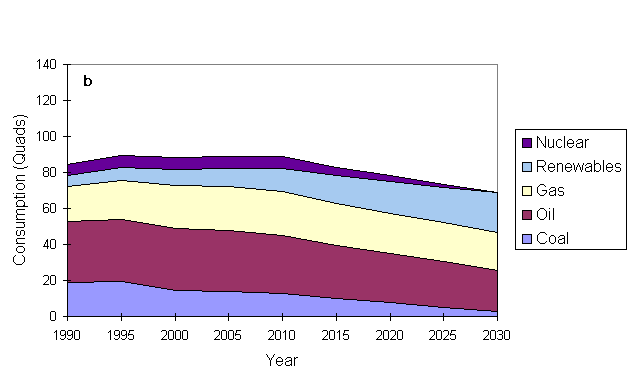 |
In the transportation sector, the fuel economies of all modes of transport increase significantly, while overall travel demand is trimmed at the same time. In industry, advanced natural gas technologies and extremely efficient combined heat-and-power (CHP) facilities totally eliminate industrial demand for purchased electricity from the grid by 2030, thereby reducing total generation in the electric sector appreciably relative to the base case in 2030. Demand for electricity is also lowered as a result of more efficient end-use technologies in the building sectors. On the generation side, highly efficient natural gas combined-cycle and fuel cell generating technologies significantly increase their role in the period 2010 - 2030, further reducing primary energy consumption in the electric power sector.
End-use energy consumptionIn the base case, end-use energy consumption increases by 48%, from 64 Quads in 1990 to nearly 95 Quads by 2030, representing an average rate of increase of 1% per year. In the innovation path, however, end-use consumption decreases over this 40-yr period to 57 quads, about 11% below the 1990 level. This represents a rate of decrease of 0.3% per year.
The largest reductions in end-use energy consumption occur for electricity and oil, which are both >50% lower in the innovation path than in the base case in 2030, and fall by about 30% relative to 1990 levels. The main causes of these respective reductions are the improvement in fuel economy and emergence of renewable fuels in the transportation sector, and the elimination by 2030 of purchased electricity by the industrial sector, as a result of on-site cogeneration facilities. Total end-use consumption of renewable fuels nearly triples in the innovation path by 2030, relative to 1990, reaching a level 80% higher than that projected in the base case.
Penetration of renewable technologiesRenewable resources contribute about one-third of primary energy by 2030, far greater than the 8% to 11% increase over four decades in the base case projections. Fig. 2 shows the breakdown of primary renewable energy consumption in the innovation path. Wind, especially, as well as biomass and geothermal, account for the near-doubling in renewables consumption in the innovation path between 1990 and 2010. The biomass contribution in 1990 is primarily in municipal solid waste for electric generation and wood for industrial energy facilities. After 2010, biomass consumption increases rapidly because of its increased use as a fuel in industry and transportation, and solar energy use also increases sharply.
FIG. 2. Primary renewable energy consumption in the innovation path.
 |
By 2030, >50% of primary renewable energy is provided by biomass. About one-third of this biomass is for electricity generation; thus, the mix of renewables for electric generation is dispersed rather evenly across the various resources by 2020 - 2030. The contribution of the electric power sector to primary renewable energy consumption declines to about 60% of the total by 2030, in accordance with the reduced generation in this sector.
Carbon emissionsFig. 3 shows snapshots of carbon emissions from fossil fuel combustion, in each of the five sectors, for the base case and innovation path in 1990, 2010, and 2030. Under the base case evolution, total carbon emissions grow at an annual rate of nearly 1%, approaching 1900 x 106 metric tons in 2030, a figure 40% higher than in 1990 (Fig. 3a). In the innovation path, on the other hand, carbon emissions are reduced by 10% relative to 1990 levels in 2010, and by 45% relative to 1990 levels in 2030 (Fig. 3b). In 2030, total carbon emissions in the innovation path are >60% lower than in the base case.
FIG. 3. Carbon emissions from fossil fuel combustion for the
base case (Base) and the innovation
path (Policy).
 |
Figures 4a and 4b compare carbon emissions in the base case and the innovation path, respectively, with emissions from the electricity-generating sector allocated to the four end-use sectors on the basis of their electricity consumption. In the base case (Fig. 4a), carbon emissions from the industrial and transportation sectors grow steadily between 1990 and 2030. In the residential and commercial sectors, on the other hand, carbon emissions grow only slightly, as a result of underlying efficiency gains in the base case. In the innovation path (Fig. 4b), carbon emissions from all four sectors decrease sharply, as a result of increased energy efficiency, fuel-switching to lower-carbon fuels (including renewables), and the lower-carbon intensity of electricity generation in the innovation path.
|
FIG. 4. Carbon emissions in (a) the base case and (b) the innovation path.
a) 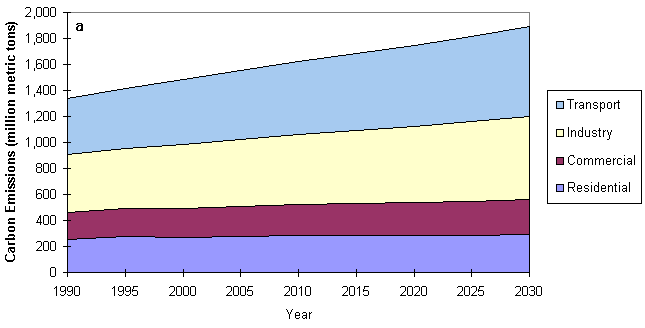  |
Cost-benefit analysis of the innovation path
In general, costs of achieving the carbon reduction described in the innovation path arise from incremental investment in capital stock in the sectors (i.e., heaters, vehicles, power plants), relative to the base case, and any additional costs incurred in administering the policies (i.e., appliance standards in the residential and commercial sectors). Benefits of the innovation path arise from fuel savings realized from policies in the five sectors, relative to the base case.
Fig. 5 shows cumulative costs and benefits of the innovation path, relative to the base case, in the residential sector. Results show that the cumulative benefits overtake the cumulative costs in 2008. Based on net present value (NPV), the discounted costs are, however, marginally higher than the discounted benefits. Benefits do not begin to accrue appreciably until after 2000, because the residential retail price of electricity in the innovation path increases relative to the base case (as calculated by NEMS), effectively countering the reduction in electricity consumption in the sector owing to efficiency policies.
FIG. 5. Cumulative costs and benefits of the innovation path in the residential sector.
 |
Fig. 6 shows cumulative costs and benefits of the innovation path, relative to the base case, in the commercial sector. The cumulative benefits overtake the cumulative costs in this sector after 1995; by 2010, benefits are eight times greater than costs on an NPV basis. There are greater conservation opportunities in this sector than in the residential sector. Moreover, the market transformation policies encourage a significant fraction of commercial entities to switch fuels in several end-uses to technologies that are less expensive than their predecessors over their life cycle.
FIG. 6. Cumulative costs and benefits of the innovation path in the commercial sector.
 |
In the industrial sector, costs associated with the innovation path were calculated directly using the Long-Term Industrial Energy Forecast (LIEF) model (Ross et al. 1993). The model calculates the electric and non-electric average cost of saved energy for each industry subsector, at the average energy price for that industry. The model then multiplies this factor by the annual electricity and non-electricity energy savings to yield a stream of annual capital investments. Fig. 7 shows that the cumulative costs and benefits of the innovation path increase nearly in tandem, with costs ending up slightly higher than benefits by 2010.
FIG. 7. Cumulative costs and benefits of the innovation path in the industrial sector.
 |
In the transport sector, Fig. 8 shows that fuel savings exceed costs almost from the outset, because the near-term opportunities for policy-induced fuel economy improvement in light-duty vehicles have very low incremental costs. All of the pre-2010 efficiency gains are achieved through refinements in conventional vehicle technology, which stem largely from the re-optimization of existing technologies for higher fuel economy, rather than for higher luxury and performance, as has been seen in current market trends. Over the entire period, the benefit-cost ratio of the innovation path in the sector is about 4:1.
FIG. 8. Cumulative costs and benefits of the innovation path in the transport sector.
 |
In the electric power sector (Fig. 9), capital, operation and maintenance (O&M), and wholesale costs all increase above the base case as a result of the supply-side policies, reflecting the incremental resource cost incurred for fuel-switching. Total fuel costs, on the other hand, decrease as a result of increased renewable generation, with no fuel costs, as well as lower demand in response to higher electricity prices. The carbon emissions reductions come from switching to cleaner resources, at a cost to the sector of $20/metric ton of saved CO2. If the costs of reducing carbon in the electric power sector are also allocated to reductions in the emissions of criteria pollutants, then the cost is lowered to $14/metric ton of CO2.
FIG. 9. Cumulative costs and benefits of the innovation path in the electric sector.
 |
Economy-wide costs and benefits
The total benefits of the innovation path heavily outweigh the total costs, with benefits overtaking costs before the turn of the century and ending up $400 billion higher on a NPV basis by 2010. Fig. 10 provides a breakdown, by sector, of the annual, levelized, economy-wide costs and benefits of the innovation path. The annual, levelized incremental investment costs are nearly $29 billion over this period. However, the annual levelized fuel savings that result would top $48 billion, yielding annual levelized savings in excess of $19 billion.
FIG. 10. Annual, levelized, economy-wide costs and benefits of the innovation path, by sector.
 |
Macroeconomic impacts of the innovation path
The macroeconomic impacts of the innovation path are clearly positive. The projected GDP increase in 2010 is $2.8 billion, which is a fraction of the $9.3 trillion projection of GDP in 2010. Wage and salary earnings rise by $14 billion in 2010, an increase of 0.27% relative to the base case. Finally, the innovation path is projected to have a positive overall impact on nationwide employment, adding nearly 800,000 new jobs in 2010.
Criteria pollutant emissions reductionIn addition to significantly altering the "business as usual" trajectory of U.S. carbon emissions, the innovation path also brings about marked reductions in emissions of criteria pollutants from all sectors of the economy. Figs. 11a - e compare the projected emissions trajectories of five major pollutants from all sectors of the economy: sulfur dioxide (SO2), nitrogen oxides (NOx), carbon monoxide (CO), particulate matter (PM10), and volatile organic compounds (VOC).
|
FIG.11. Projected emissions trajectories under the innovation
path for criteria pollutants: (a) sulfur dioxide (SO2), (b)
nitrogen oxides (NOx), (c) carbon monoxide (CO), (d)
particulate matter (PM10), and (e) volatile organic
compounds (VOC).
a) SO2 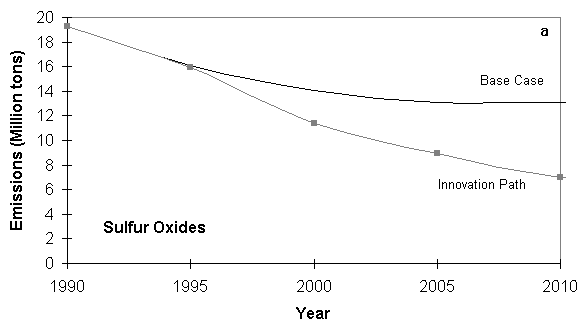 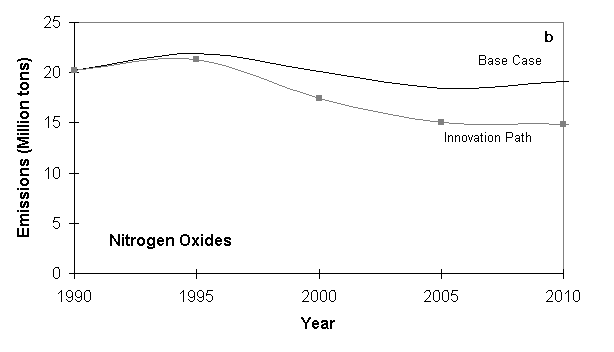 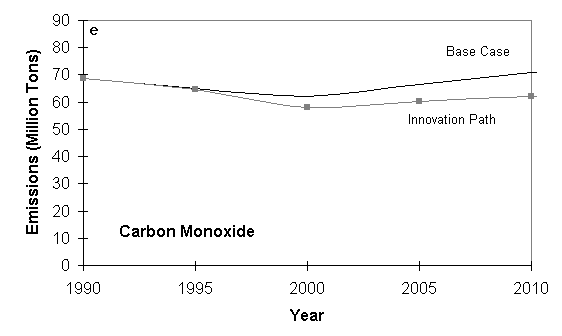 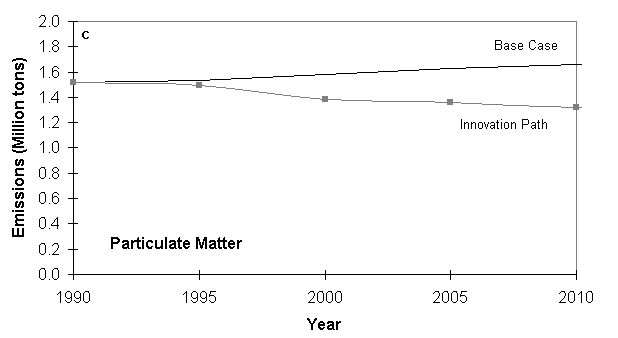 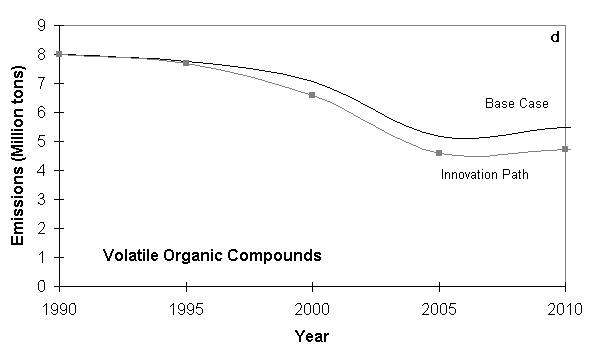 |
The analysis summarized in this paper explores the technical and economic potential for the United States to reduce its carbon emissions. Results show that an integrated, multisectoral innovation path can result in significant carbon emissions reductions while yielding net benefits to the U.S. economy. The innovation path reduces carbon emissions by 26% below baseline projections for 2010 and 62% below baseline projections for 2030, equivalent to 10% below 1990 levels in 2010 and 45% below 1990 levels in 2030. The constituent policies also provide substantial ancillary benefits in the form of reductions in criteria pollutant emissions, reductions in U.S. imports of oil, and the stimulus for energy-related technological innovation and diffusion into the economy.
The economic and macroeconomic impacts of the innovation path are positive. It produces net savings of $19 billion (1993 dollars) on an annual, levelized basis through 2010, and increases GDP, personal income, and employment relative to a "business as usual" scenario.
Responses to this article are invited. If accepted for publication, your response will be hyperlinked to the article. To submit a comment, follow this link. To read comments already accepted, follow this link.
Acknowledgments
The authors would like to thank the following for their input and contributions: John DeCicco and Neal Elliott, American Council for an Energy-Efficient Economy; Jason Mark and Roland Huang, Union of Concerned Scientists; Skip Laitner, U.S. Environmental Protection Agency; Peter Miller and Dan Lashof, Natural Resources Defense Council; and Michael Ruth, Tellus Institute. The authors would also like to express their gratitude to Alden Meyer of the Union of Concerned Scientists, Howard Geller of the American Council for an Energy-Efficient Economy, and Doug Norland of the Alliance to Save Energy for their input and guidance.
EIA. 1996. Annual energy outlook 1996. U.S. Department of Energy, Energy Information Administration, Washington, D.C., USA.
Energy Innovations. 1997. Energy Innovations: A Prosperous Path to a Clean Environment. Alliance to Save Energy, American Council for an Energy-Efficient Economy, Natural Resources Defense Council, Tellus Institute, and Union of Concerned Scientists, Washington, D.C., U.S.A.
Ross, M., P. Thimmapuram, R. Fisher, and W. Maciorowski. 1993. Long-term Industrial Energy Forecasting (LIEF) Model (18-Sector Version). Argonne National Laboratory, Argonne, Illinois, USA.
World Resources Institute, United Nations Environment Programme, United Nations Development Programme, and the World Bank. 1996. World Resources 1996-1997. Oxford University Press, Oxford, UK.
Address of Correspondent:
Stephen Bernow
Tellus Institute
11 Arlington St.
Boston, Massachusetts 02116 USA.
phone: 617-266-5400
fax: 617-266-8303
sbernow@tellus.org
*The copyright to this article passed from the Ecological Society of America to the Resilience Alliance on 1 January 2000.